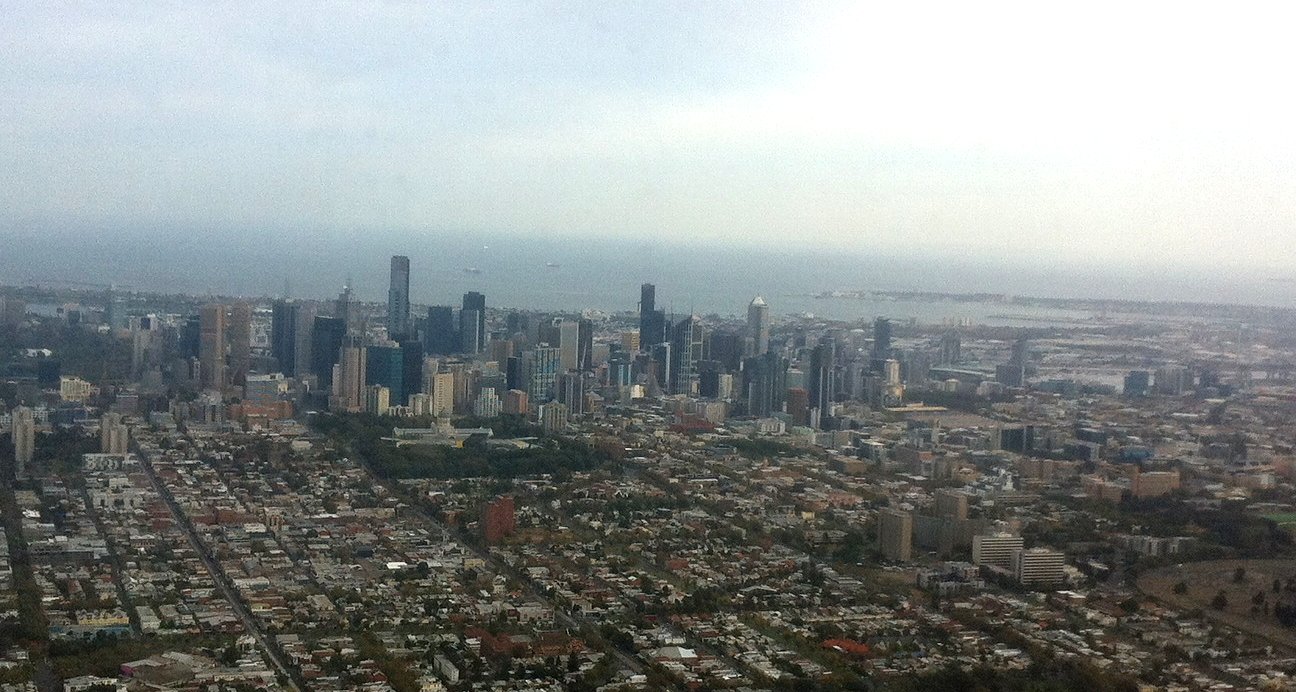
Melbourne, now the capital city of the state of Victoria in Australia, was founded in 1835. The exact circumstances of the foundation of Melbourne, and the question of who should take credit for its foundation, have long been matters of dispute.
The south-east coast of the Australian continent was discovered by a series of navigators, mostly operating from Sydney, including George Bass in 1797 and James Grant in 1800. John Murray in the Lady Nelson was the first to sail into Port Phillip in 1801, but he did not reach the northern end of the bay. In January 1803, Charles Robbins and Charles Grimes in the Buffalo explored the whole of the bay, and discovered the Yarra River, which they rowed up as far as Dight’s Falls at Kew.

The British government was keen to establish a settlement somewhere on the coast of Bass Strait, in order to forestall the French, whom they suspected (falsely) of planning to build a base in the area of this important shipping lane. So in April 1803 David Collins was sent from Sydney to establish a settlement. Not being aware of the discoveries of Robbins and Grimes, Collins settled at a spot near Sorrento on the Mornington Peninsula.
After a few months the sandy soil and lack of drinking water caused the settlement to be abandoned, and transferred to Hobart in Van Diemen’s Land (now Tasmania). Among the settlers at Sorrento was an eleven-year-old boy called John Pascoe Fawkner (20 October 1792 – 4 September 1869, born in London and transported to Australia with his convict father. He eventually settled in Launceston, in northern Tasmania, becoming a publican and newspaper proprietor. He was a shrewd and successful businessman, but widely disliked.
Among the other early settlers in Tasmania was John Batman (21 January 1801 – 5 May 1839), born in Parramatta, New South Wales, the son of a convict. He had settled in Tasmania as a young man, and took part in the infamous “Black Line” campaign to round up the last remaining Tasmanian Aboriginal people. He become a successful farmer in northern Tasmania, but he wanted more land for his flocks, and he knew of the existence of the unsettled lands of “Australia Felix” on the northern shore of Bass Strait. Other Tasmanian graziers had the same idea. In 1834 the Henty family established the first European settlement in what is now Victoria, at Portland.
When news of the Hentys’ actions reached Launceston, Batman and a group of friends founded the Port Phillip Association, with the intention of settling at Port Phillip. In April 1835, Batman hired a sloop called the Rebecca and sailed across the Strait and up Port Phillip to the mouth of the Yarra. He explored a large area in what is now the northern suburbs of Melbourne, as far north as Keilor. It was, he wrote, “Land of the best description, equal to any in the world… the most beautiful sheep pasturage I ever saw in my life.”
On 6 June Batman recorded in his journal that he had signed a “treaty” with the local Aboriginal people, the Wurundjeri. In this “treaty” Batman purported by buy 200,000 hectares of land around Melbourne and another 40,000 hectares around Geelong, on Corio Bay to the south-west. In exchange he gave the eight “chiefs” whose marks he acquired on his “treaty” a quantity of “blankets, knives, tomahawks, scissors, looking-glasses, flour, handerchiefs and shirts.”
This “treaty” was legally invalid – under British law the land around Port Phillip belonged to the Crown, not to the Wurundjeri, and they had no more right to sell it than Batman had to buy it. In any case the Wurundjeri had no “chiefs”, and the Aboriginal people had no concept of land “ownership.” The Wurundjeri would never have agreed to alienate their land even if they had understood what Batman was proposing.
It is more than likely, moreover, that there was no no “treaty” at all. The historian Alistair Campbell has pointed out that the marks allegedly made by the “chiefs” are similar to markings made on trees by the Aboriginal people around Parramatta, where Batman grew up. Campbell’s view is that the whole “treaty” was a fabrication, designed to give Batman and his association some claim to ownership of what would soon become valuable land.
Batman then sent a party up the Yarra by boat. On 8 June he wrote in his journal: “So the boat went up the large river… and… I am glad to state about six miles up found the River all good water and very deep. This will be the place for a village.” This last sentence later became famous as the “founding charter” of Melbourne, but it is not at all clear whether Batman was referring to the Yarra or its tributary the Maribyrnong. The map Batman later produced does correspond well with the actual geography of the area.

It was the policy of the British government at this time that settlement in Australia should be confined to the proclaimed “Settled Areas” until new lands could be surveyed and sold by the Crown. Accordingly, in August Sir Richard Bourke, the Governor of New South Wales, issued a proclamation that Batman’s “treaty” was void and that anybody settling at Port Phillip would be trespassing.
Batman returned to Launceston and began plans to mount a large expedition to establish a settlement on the Yarra. But Fawkner had not been idle during the period since news of the Henty settlement at Portland had reached him. He also bought a ship, the schooner Enterprize. He met with Batman and assured him that he was not intending to settle at the site of Batman’s discoveries, but he in fact had every intention of doing so. The Enterprize sailed on 4 August, with a party of intending settlers, although Fawkner was not aboard because the local sheriff would not allow him to leave until he paid his many debts.
After looking around the area, the acting commander of the expedition, John Lancey, chose a spot for the settlement, where, on 30 August 1835, the ship was anchored and the goods aboard unloaded. The spot was on the north bank of the Yarra, roughly between the present Spencer St Bridge and the Kings Bridge, in what is now called Enterprize Park.
Meanwhile Batman had sailed from Launceston in the Rebecca on 20 July, but he had spent several weeks at a temporary camp site at Indented Head on the western side of the bay. Here he was amazed to meet an Englishman, William Buckley, a former convict who had escaped from the settlement at Sorrento in 1803 and who had lived with the Aboriginal people around Port Phillip for more than 30 years. So it was not until 2 September that Batman’s party reached the Yarra, where they were dismayed and angry to find Fawkner’s people already in possession.
After a tense standoff, the two groups decided that there was plenty of land for everybody, and when Fawkner arrived on 16 October with another party of settlers, he agreed that they should start parcelling out land and not dispute who was there first. It was in his interests to do this, since an outbreak of violence would make it even less likely that Governor Bourke would recognise the settlement and the legal land titles of the settlers.
Both Batman and Fawkner settled in the new town, which had several interim names before being officially named Melbourne in honour of the British Prime Minister, Lord Melbourne, in March 1837. Batman farmed at “Batman’s Hill,” an area now covered by the Spencer St railway yards. He was an alcoholic and had advanced syphilis, and he died young in 1839.
Fawkner, on the other hand, had a long and stormy career in the colony. He opened Melbourne’s first hotel on the corner of William St and Flinders Lane. He founded the Melbourne Advertiser, the city’s first newspaper, in 1838. He became a major landowner at Pascoe Vale, north of Melbourne. In 1851 he was elected to the first Legislative Council of the Port Phillip District, and in 1856 he was elected to the first Parliament of the self-governing colony of Victoria, as MLC for Central Province. In Melbourne as in Launceston, he made many enemies, before dying as the grand old man of the colony in 1869.
In later years Fawkner’s enemies had their revenge, because they decided to credit Batman, long dead and safely forgotten, as the founder of what was by then “Marvellous Melbourne,” the golden city of the British Empire. Batman’s sentence, “This will be the place for a village,” was widely quoted to show that Batman had envisaged a town on the site of Melbourne. In his 1856 history of the colony, Batman was given pride of place as the founder of Melbourne, and Henry Gyles Turner followed this in his 1904 History of the Colony of Victoria. In his 1979 biography of Batman, C B Billot again credited him as the founder of Melbourne.
In 1985, however, Billot changed his mind after reading Fawkner’s papers in the State Library of Victoria and his diary in the National Library of Australia. In his book The Life and Times of John Pascoe Fawkner, he agreed that the idea and the fact of a town at the site of Melbourne should be credited to Fawkner, while Batman’s chief intention was to establish a sheep-run, as the Hentys had done at Portland. A critical reading of Batman’s journal showed that Batman probably did not visit the site of Melbourne, and that his map bears little resemblance to the actual site. Alistair Campbell’s 1987 John Batman and the Aborigines also unfavourably reassessed Batman’s reputation, arguing that his “treaty” was probably bogus as well as illegal.
In recognition of this reassessment, a section of Batman Park, along the north bank of the Yarra where the first settlement was established, was renamed Enterprize Park in 1997. Both Batman and Fawkner have many streets, parks and other things in Melbourne named after them. There is a suburb called Fawkner and his estate at Pascoe Vale is now also a suburb.
